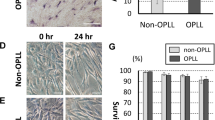Abstract
Purpose
The aim of this study was to investigate the potential role of vimentin in the signal transduction pathways initiated by mechanical stimulation that contribute to ossification of the posterior longitudinal ligament of the spine (OPLL).
Methods
We investigated the effects of in vitro cyclic stretch on cultured spinal ligament cells derived from OPLL (OPLL cells) and non-OPLL (non-OPLL cells) patients. The expression levels of the osteoblast-specific genes encoding osteocalcin (OCN), alkaline phosphatase (ALP), and type I collagen (COL I) were assessed by semi-quantitative reverse transcription-polymerase chain reaction. Vimentin protein expression in OPLL cells was detected by Western blotting. Small interfering RNA (siRNA) interference targeting vimentin was performed in OPLL cells induced by mechanical stress, and the expression levels of OCN, ALP and COL I were assessed.
Results
In response to mechanical stretch, the expression levels of OCN, ALP, and COL I were increased in OPLL cells, whereas no change was observed in non-OPLL cells. Furthermore, knockdown of vimentin protein expression by siRNA resulted in an increase in the mRNA expression levels of OCN, ALP, and COL I.
Conclusion
The down-regulation of vimentin induced by mechanical stress plays an important role in the progression of OPLL through the induction of osteogenic differentiation in OPLL cells.





Similar content being viewed by others
References
Azuma Y, Kato Y, Taguchi T (2010) Etiology of cervical myelopathy induced by ossification of the posterior longitudinal ligament: determining the responsible level of OPLL myelopathy by correlating static compression and dynamic factors. J Spinal Disord Tech 23:166–169
Matsunaga S, Sakou T (2012) Ossification of the posterior longitudinal ligament of the cervical spine: etiology and natural history. Spine (Phila Pa 1976) 37:E309–E314
Matsunaga S, Sakou T, Taketomi E, Komiya S (2004) Clinical course of patients with ossification of the posterior longitudinal ligament: a minimum 10-year cohort study. J Neurosurg 100:245–248
Matsunaga S, Sakou T, Taketomi E et al (1994) The natural course of myelopathy caused by ossification of the posterior longitudinal ligament in the cervical spine. Clin Orthop Relat Res 305:168–177
Nakamura H (1994) A radiographic study of the progression of ossification of the cervical posterior longitudinal ligament: the correlation between the ossification of the posterior longitudinal ligament and that of the anterior longitudinal ligament. Nihon Seikeigeka Gakkai Zasshi 68:725–736
Takatsu T, Ishida Y, Suzuki K, Inoue H (1999) Radiological study of cervical ossification of the posterior longitudinal ligament. J Spinal Disord 12:271–273
Chien S (2007) Mechanotransduction and endothelial cell homeostasis: the wisdom of the cell. Am J Physiol Heart Circ Physiol 292:H1209–H1224
Herrmann H, Aebi U (2004) Intermediate filaments: molecular structure, assembly mechanism, and integration into functionally distinct intracellular scaffolds. Annu Rev Biochem 73:749–789
Ivaska J, Pallari HM, Nevo J et al (2007) Novel functions of vimentin in cell adhesion, migration, and signaling. Exp Cell Res 313:2050–2062
Steinert PM, Liem RK (1990) Intermediate filament dynamics. Cell 60:521–523
Gotz M, Hartfuss E, Malatesta P (2002) Radial glial cells as neuronal precursors: a new perspective on the correlation of morphology and lineage restriction in the developing cerebral cortex of mice. Brain Res Bull 57:777–788
Lopez-Egido J, Cunningham J, Berg M et al (2002) Menin’s interaction with glial fibrillary acidic protein and vimentin suggests a role for the intermediate filament network in regulating menin activity. Exp Cell Res 278:175–183
Lian N, Lin T, Liu W et al (2012) Transforming growth factor beta suppresses osteoblast differentiation via the vimentin activating transcription factor 4 (ATF4) axis. J Biol Chem 287:35975–35984
Lian N, Wang W, Li L et al (2009) Vimentin inhibits ATF4-mediated osteocalcin transcription and osteoblast differentiation. J Biol Chem 284:30518–30525
Shapiro F, Cahill C, Malatantis G et al (1995) Transmission electron microscopic demonstration of vimentin in rat osteoblast and osteocyte cell bodies and processes using the immunogold technique. Anat Rec 241:39–48
Harter LV, Hruska KA, Duncan RL (1995) Human osteoblast-like cells respond to mechanical strain with increased bone matrix protein production independent of hormonal regulation. Endocrinology 136:528–535
Barakat AI, Leaver EV, Pappone PA et al (1999) A flow-activated chloride-selective membrane current in vascular endothelial cells. Circ Res 85:820–828
Olesen SP, Clapham DE, Davies PF (1988) Haemodynamic shear stress activates a K + current in vascular endothelial cells. Nature 331:168–170
Meyer CJ, Alenghat FJ, Rim P et al (2000) Mechanical control of cyclic AMP signalling and gene transcription through integrins. Nat Cell Biol 2:666–668
Tzima E, Irani-Tehrani M, Kiosses WB et al (2005) A mechanosensory complex that mediates the endothelial cell response to fluid shear stress. Nature 437:426–431
Rosenberg N (2003) The role of the cytoskeleton in mechanotransduction in human osteoblast-like cells. Hum Exp Toxicol 22:271–274
Shyy JY, Chien S (2002) Role of integrins in endothelial mechanosensing of shear stress. Circ Res 91:769–775
Ishida Y, Kawai S (1993) Characterization of cultured cells derived from ossification of the posterior longitudinal ligament of the spine. Bone 14:85–91
Iwasawa T, Iwasaki K, Sawada T et al (2006) Pathophysiological role of endothelin in ectopic ossification of human spinal ligaments induced by mechanical stress. Calcif Tissue Int 79:422–430
Conflict of interest
None.
Author information
Authors and Affiliations
Corresponding author
Rights and permissions
About this article
Cite this article
Zhang, W., Wei, P., Chen, Y. et al. Down-regulated expression of vimentin induced by mechanical stress in fibroblasts derived from patients with ossification of the posterior longitudinal ligament. Eur Spine J 23, 2410–2415 (2014). https://doi.org/10.1007/s00586-014-3394-8
Received:
Revised:
Accepted:
Published:
Issue Date:
DOI: https://doi.org/10.1007/s00586-014-3394-8




